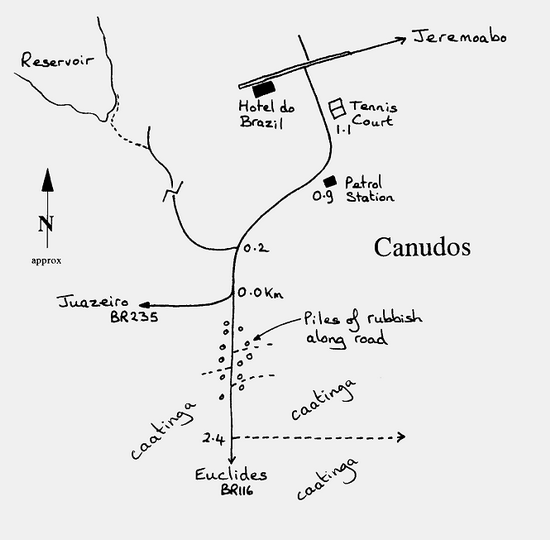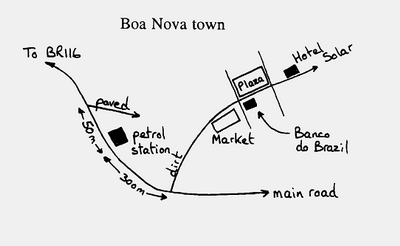Section 1 - Introduction, logistics, itinerary and general information.
Section 2 - Birding sites (part 1).
Section 3 - Birding sites (part 2).
Section 4 - Birding sites (part 3).
Section 5 - Annotated checklist.
Curaçá
The small town of Curaçá in north-west Bahia, has become the mecca for those wishing to find Spix's Macaw - the last wild individual of which occurs in Caraiba gallery woodland near the town. In a last-ditch effort to save the species from extinction a project, backed by several international conservation bodies, has been established in an attempt to reintroduce a viable population into the wild. The project base, about 20 kilometres from Curaçá, includes a large holding cage which, in October 94, held a single female of wild origins. (This female was subsequently released in 1995). Visitors wishing to try for Spix's Macaw must first obtain permission from the project director Iolita Bampe at IBAMA-Brasília and, when in Brazil, contact Marco do Ré, the project field director in Curaçá. It should be stressed that without a permit, and the assistance of Marco it would be nigh-on impossible to locate the Macaw. Even with these, a good deal of luck is required. As the bird covers large distances during any day, we considered ourselves extremely fortunate to find it within two days.
The best accommodation in Curaçá, the Hotel Casa Grande, is adequate, though somewhat basic, and cost $20 per night for a triple room. The Gato Restaurant, just around the corner from the hotel, serves excellent food and appeared to be the best place by far to eat. During our time at Curaçá, Marco took us to various points where the Spix's Macaw might be seen flying over or feeding, as well as introducing us to the local people and showing us the project headquarters, and the captive female bird. Although plagued by the over-grazing of goats, the habitat around Curaçá makes for good birding. Whilst spending long sessions standing around hoping for Spix's to fly over, many other good species were observed, including Bicoloured Hawk, White-browed Guan, Red-legged Seriema, Blue-winged Macaw, Pygmy Nightjar, and Crimson-throated Tanager. The area is also good for nightbirds. Apart from time spent looking for Spix's Macaw we also birded two dried-up water-courses near Curaçá. The best was around 13 kilometres from Curaçá on the main road to Juazeiro (no road number), where we saw several Greater Wagtail-Tyrant. On leaving Curaçá we spent a few hours, on Marco's recommendation, along the large, dried-up water course 20 kilometres out on the dirt road to Barro Vermelho. This dirt road, which forms a short cut to Canudos, starts two to three kilometres out of Curaçá on the Juazeiro road, just after the first road culvert - also identified by a large IBAMA sign on the left (east).
Species recorded from Curaçá:
Small-billed Tinamou 1h |
Amazon Kingfisher 1 |
Canudos
Canudos, previously named Cocorobo, is situated within a large caatinga area known as the Rasa da Catarina in northern Bahia. A variety of dry habitats are found within the general area, together with a large man-made reservoir, providing a permanent water habitat, adjacent to the town. Both access roads to Canudos (BR116, BR235) are dirt, which although sandy in places were readily passable to our two-wheel-drive whilst there.
We stayed at the small but friendly, family-run, Hotel do Brazil in town (see map), which was one of the nicest places we stayed throughout our trip, and which we highly recommend. Breakfast, dinner and one night's accommodation worked out at $45 for the three of us. Our best birding was along a wide track running east from the main BR116 Canudos to Euclides road, south of town. The track starts 2.4 kilometres south of the BR235 turnoff. Scrub around the reservoir was also briefly investigated, but held little of interest.
|
Without a permit we would probably have been taken back to Canudos for questioning. |
Previously, visitors wishing to see Lear's Macaw required only a permit from IBAMA-Salvador. However, continuing collecting pressure, resulting in a still diminishing number of birds, has been taken seriously by the project director in Belo Horizonte, who now must be contacted in advance. We found him extremely helpful, and in addition to granting us permission to seek Lear's Macaw, provided the necessary clearance to enter the private land on which they were currently roosting, and permission to use the organisation's only four-wheel-drive and driver. He also requested that we not to divulge details of our observations of Lear's Macaw. From our experiences it appears likely that future requests for permits might be denied in the interest of limiting knowledge of the species whereabouts. Once having obtained all the necessary authorizations, it is necessary to contact Antônio Florêncio da Costa in Canudos (ask at the hotel), one of the SEMA wardens who will accompany you to the site. Note that as the birds have several feeding and roosting sites, camping equipment might well be necessary.
Working any of the caatinga around town should produce the threatened Red-shouldered Spinetail, which appears to be fairly common in semi-dense caatinga, 2-3 metres high. We saw several individuals along the track outlined above. Another good area appears to be around the village of Cen Cinquenta, five kilometres out along the Jeremoabo road.
Little Tinamou |
Pale-legged Hornero 4 |
Boa Nova
Boa Nova must rate as one of the most important forest areas of the Atlantic coast. Unfortunately, as none of the habitat here is afforded any protection, clearance and wood cutting continues unabated. Although small in extent, due to its great habitat diversity, the area holds many important species; including the Red-data book Hook-billed Hermit, Striated Softtail, Slender Antbird, Narrow-billed Antwren, and Rio de Janeiro Antbird. The current species list for the area - nearly 400 - is impressive, with new species being discovered at almost all visits by birders. Two new species to science have recently been documented from Boa Nova; Bahia Tyrannulet (Gonzaga and Pacheco, 1995), and an, as yet, undescribed Synallaxis Spinetail (Gonzaga et al., 1995). At least four to five days are required to just-about adequately cover the area, and up to a week would be beneficial. Access to Boa Nova is along the well-paved road running east from the BR116, about 62 kilometres south of Jequié.
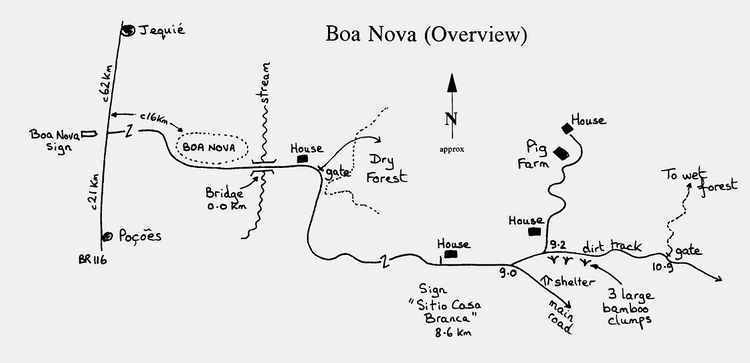
|
Accommodation is available at the small, but comfortable, family-run Hotel Solar in Boa Nova, where the owner, accustomed to birders, even provides early breakfasts and packed lunches. Prices are $20 per room (up to three people). Address: Pousada Solar, Rua Duque de Caxias 39, Centro, CEP 45250 Boa Nova, BA. Tel (073) 433-2181. Our total five days including all accommodation, meals and drinks came to $350 for three people. The hotel is located just off the main plaza in town. Birding can be concentrated in two areas; dry forest just east, and wet forest 11 kilometres east, of Boa Nova. Other scrub and semi-arid habitats in the area can be accessed from roads and tracks by those with more time. Undoubtedly this would produce some interesting surprises. |
Wet Forest. See Boa Nova (Wet forest) map. Three of our four full days were spent in this forest type. Although lying at the same altitude (800 metres) and being only a mere ten kilometres east of the dry forest, rainfall is considerably greater, and one should take into account that birding here could be rained-out for the greater part of any day. Evidently, many changes have occurred to access here in the last few years, as the apparently well-drawn map we had bared no resemblance what-so-ever to the situation we found. We therefore tried as many trails as possible on a trial-and-error basis, until we found good forest. Good forest is restricted to remnant patches on the ridges, with only secondary growth near the main track.
From the bridge at Boa Nova, drive eastward 9.0 kilometres and take the wide dirt-track on the left. This turn off is 0.4 kilometres past a house on the left with a large white sign reading "Sitio Casa Branca". As this track is not passable to two wheel-drive-vehicles after rain, it is safer to leave the car at the first fork, two hundred metres in from the road, and walk. The left track of this first fork leads to a house and pig farm after about a kilometre, above which coffee shade-forest and a forested ridge are found. For those with plenty of time, his area could well be worth exploring. The best forest we discovered is accessed via a gate on the left 1.9 kilometres from the main road. This spot can most easily be recognised by the small pond visible about 100 metres down-hill from the track. Additionally this is the point where the high voltage power lines pass closest to the road on the right (south) side.
The area adjacent to the pond is quite marshy, and would certainly warrant exploration with a pair of rubber boots, as Blackish Rail and Ash-throated Crake have both been recorded. After passing the pond, the path swings right, then left and passes a gallery forest strip about 400 metres from the gate. One hundred metres past the gallery strip, an old, over-grown logging road (subsequently referred to as the OLR) branches in from the right. Wedge-tailed Grass-Finch occurs around this intersection. At this point you have the choice of continuing straight-on or taking the OLR. Initially it is probably better to take the OLR, as access into the forest directly from the plantations (where the straight-on path leads) may be difficult to find. The OLR, evidently cleared many years ago, initially climbs slowly through open grassland for about 500 metres, and then enters the forest. We found that the old secondary growth along the OLR, within the main primary forest, provided the best species diversity - particularly for antbirds. Species seen along this trail but not elsewhere included Hook-billed Hermit, Ochre-rumped Antbird and White-bibbed Antbird. Within the forest, the OLR runs steadily up-hill in the straight line for about 500 metres, levels-out on top of the ridge, and ends a 150 metres further. From here it is possible to follow a narrow trail, but this rapidly deteriorates. However, along this trail was the only place we saw Pale-browed Treehunter.
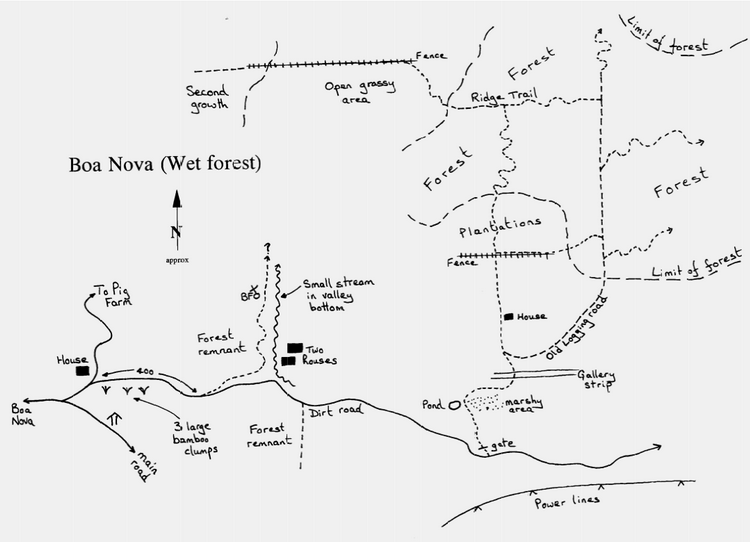
Finding the ridge trail from the OLR could be tricky, as its start is blocked from view by a tree-fall. It starts on the left (west) just after the point where the OLR levels out completely. The ridge trail, at 1,000 metres altitude, passes through dense cloud forest, and runs for about 600 metres after which it emerges into open grassland. The trail can be still be followed across the grassland, and enters the next patch of (secondary) forest, a kilometre or so away, where it still appears to follow the ridge (we didn't explore this section). From within the cloud forest a steep trail leads downward, through good forest to the plantations, the start of which is fairly obvious, two-thirds of the way along the ridge trail from the OLR to the open grassland. Rio de Janeiro Antbird was only seen along this trial, and a pair of Variegated Antpitta have a territory near the bottom of the trail.
Several other trails branch off the OLR. We briefly tried all we discovered. The two trails branching off right (east) provide access through continuous forest to the next forested ridge. However, they are evidently little used, as due to tree falls, they become difficult to follow after several hundred metres. The first (lower) trail on the left (west) descends through extensive bamboo and emerges from the forest to follow the fence down to the plantation area. As such it can be used as a short-cut to the start of the forest trail above the plantations. Another good trial, which we had insufficient time to investigate thoroughly, starts on the left (north) side about 600 metres from the main road, and about 200 metres before the two houses (see map). This wide trail winds up through heavily cut-over, old secondary growth, and we suspect that it connects with the ridge trail eventually. It was along this trail, (600-700 metres from the track) that we discovered Buff-fronted Owl in tall trees on the left, having responded, in daylight, to an imitation of its whistle. This trail was also the only place we saw Variable Antshrike and Planalto Woodcreeper.
Although only secondary forest remains, birding along the along the main track is decidedly worthwhile. We encountered several species not seen elsewhere, including Scale-throated Hermit, Ruby Topaz Hummingbird and the endangered Striated Softtail. The softtail was seen on two occasions in dense tangles immediately adjacent to the left (north) side of the track just at the base of the valley below the two houses.
Dry Forest. See Boa Nova (Dry forest) map. One to two days should be sufficient to find the specialities within this habitat, though the Pale-headed Spinetail may now prove difficult, as we failed to find it in areas previously encountered by others. Leave Boa Nova eastward on the main road, and cross the bridge just east of town, where the paved road ends. Within the next couple of hundred metres or so the road passes the only house on the left, after which a wide, driveable, dirt track winds up the hill into dry forest. A simple barbed wire gate bars access to this track, though whether this is merely to keep cows in or visitors out is unclear. In view of the number of local people entering, we presumed the former and drove 1.3 kilometres along this track and parked at the next gate (gate C on map). Alternatively one could just climb over the fence (as do the locals) a few meters to the right of the gate and walk up through the dry forest. An alternative, and probably better, shorter access is provided by entering via gate B which is 1.0 kilometres from the bridge.
Slender Antbird (marked SA on the map) appeared to be fairly common around ground bromeliads that occur in the higher-elevation parts of the dry forest. Narrow-billed Antwren and Pallid Spinetail were found in the same area. Slender Antbird was also singing in forest adjacent to gate C. It is noteworthy that supposed Pileated Antwren seen in this area differ markedly from other populations in Bahia, and may represent a different form or species (see annotated checklist for a full discussion). Note: the map shows the situation as we found it. As clearance, burning, cultivation and construction of fences proceeds, changes may well occur in access tracks and trails. The situation on-the-ground is further complicated by an abundance of paths and trails created by cows and horses grazing the area. Only principle tracks have been drawn on the map, and visitors may well find other accesses to good forest.
On our drive away from Boa Nova, 19.5 kilometres south of Ibitupâ (itself about 55 kilometres east of Boa Nova), we passed an excellent small lake where we saw Brazilian Teal and Black-crowned Night-Heron. No doubt the dense reeds surrounding this lake held numerous crakes and rails. We also noted that ridges around the town of Ibicarai were extensively covered with coffee shade-forest, and would almost certainly hold many species of interest. Ibicarai, 100 kilometres south-east of Boa Nova, is a sizeable village so basic accommodation should be available.
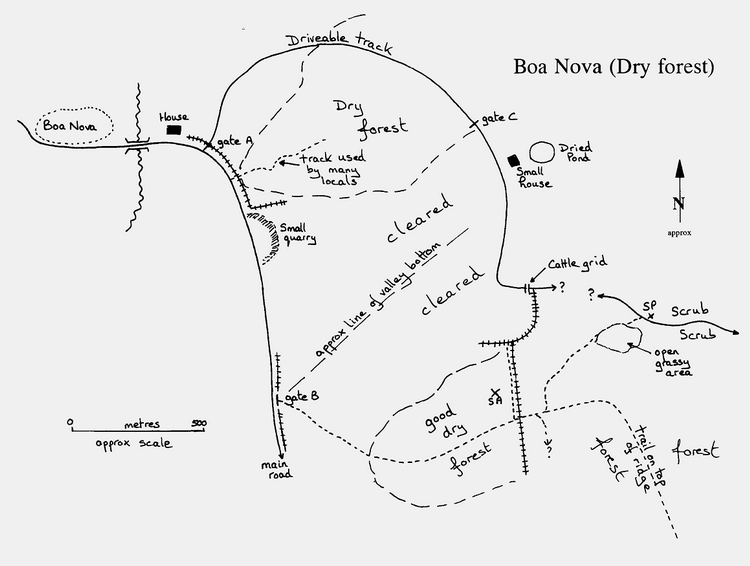
Species recorded from Boa Nova: (w) = species of wet forest. (d) = species of dry forest.
Solitary Tinamou |
Stripe-backed Antbird 2 (d) |
Section 1 - Introduction, logistics, itinerary and general information.
Section 2 - Birding sites (part 1). .
Section 4 - Birding sites (part 3).
Section 5 - Annotated checklist.

